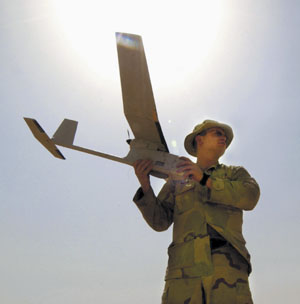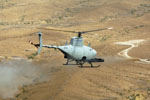Unmanned Aircraft Systems Grow Up
 |
| The U.S. military is rapidly procuring large numbers of small hand-launched unmanned aircraft systems (UASs), such as this Raven UAS being deployed in Iraq. According to the Unmanned Aircraft Systems Roadmap, a document produced by the Unmanned Aircraft Systems Planning Task Force, the services have procured more than 1,500 small UAS platforms in the past three years. |
From large strategic reconnaissance platforms to squad-level hand-launched planes, unmanned aircraft are moving into new operational niches such as hunter-killer and strike missions across all echelons of the U.S. military. As these systems continue to develop, sophisticated networking technologies will permit them to interoperate with manned aircraft and a variety of remotely operated ground and sea vehicles.
Coordinating the future growth and development of unmanned aircraft programs is the responsibility of the U.S. Defense Department’s Unmanned Aircraft Systems Planning Task Force (PTF), Office of the Secretary of Defense,
Published in 2000 and 2003, the most recent iteration of the road map was released in August. Weatherington notes that the PTF formed in the wake of the September 11, 2001, terrorist attacks to coordinate but not direct the development activities of the services. Although a number of unmanned aerial vehicle (UAV) development activities existed before 2001, no effective, overarching management structure was in place to direct their efforts, he says.
The most recent road map changes the term UAV to unmanned aircraft system (UAS). Weatherington explains that this emphasizes a capability over the platform that is only a part of the entire package. “Not that the vehicle is unimportant, but the vehicle by itself doesn’t provide that capability. It’s the system that provides the capability,” he says.
Over the past two years, the Defense Department has seen a significant increase in the number of UAS types developed and in service with warfighters. Small hand-launched UAVs have experienced the most growth in numbers and operational use. “Three years ago, the total inventory from all the services was maybe 100 small UAVs. Today, we have well over 1,500 in the inventory. Most of those are deployed supporting combat operations,” he says.
Weatherington believes that this trend toward small systems will continue to grow. The PTF is examining the technology requirements and policy issues affecting the operational use of small UAVs. Considerations include spectrum management, airspace integration, arming UAVs, and the technology and policy implications to use these systems safely and effectively in strike applications. He adds that a number of broad policy ramifications touch individual programs and affect almost every unmanned system currently flying.
Noting the recent growth in the use and procurement of small tactical systems, Weatherington explains that hand-launched UAVs provide infantry squads with something they never had before—the ability to discover what is over the next hill or around the corner safely. “Now that you’ve given them that capability, they’re ecstatic because it makes their jobs easier and provides them with a level of security that they never had before,” he says.
Another advantage offered by small UAV systems is that they can be developed and put into service quickly. “In just the space of three years, we’ve gone from having them [hand-launched UAVs] used by a few special operations units to something that’s now becoming almost standard across a broad spectrum of warfighting capabilities,” he says.
Besides tactical systems, also highlighted in the road map are issues affecting all types of UAS platforms. Weatherington explains that one area that continues to demand ongoing policy attention is airspace integration: the ability for UAVs to operate together and with manned platforms in the same area. He notes that in 2002, the Defense Department identified airspace integration as a challenge and has been working to address the issue. Early operational concepts saw UAVs operating alone in lightly occupied airspace, but UAVs now share the sky with a variety of manned and unmanned aircraft in some theaters of operation.
But airspace management systems have not yet reached their full potential and are still somewhat cumbersome to operate, Weatherington admits. He adds that the PTF is taking steps to improve technologies and procedures to make the process more efficient and seamless. However, in more than three years of operation, the Defense Department has never had a serious incident involving UAVs. Weatherington credits the experience the military has gained in operating unmanned aircraft individually and with other platforms.
Efforts are underway to resolve airspace integration issues within the Defense Department and in other government agencies such as the U.S. Department of Homeland Security (DHS). These policy considerations include interagency cooperation. Weatherington notes that the DHS recently procured its first UAS and is moving into this operational domain. Other agencies involved in UAS policies include the Federal Aviation Administration, which determines procedures for operations in national airspace, and international organizations because UAVs operating beyond
Spectrum management also remains a challenge for UAS platforms. Weatherington explains that the Defense Department is not gaining additional spectrum and that the best it can do is to manage its existing frequency bands more efficiently. Because of the inherent connectivity of unmanned aircraft, significant challenges can arise if communications applications are not taken into consideration. He notes that although the PTF has not yet encountered any hard spectrum issues, system development faces many challenges. “The real issue is that in the next five, 10, 15 years, we have to plan for operations in those time frames and with projected force structures. That requires us to review and in some cases make fundamental changes in our spectrum policies,” he says.
Another consideration is linking UAVs into existing and future communications and data networks. But Weatherington explains that managing network-centric systems remains a moving target for the PTF. “The fact that these systems are at the quintessential front end of a network-centric capability demands that they get a lot of attention as to how they integrate into network-centric operations,” he says.
 |
| According to Dyke Weatherington, deputy of the Unmanned Aircraft Systems Planning Task Force, as combat-capable UAS platforms such as this Fire Scout unmanned aerial vehicle begin to enter service in greater numbers, they will create operational niches for themselves in the same way the current generation of unmanned reconnaissance platforms have. |
The agency also is determining which functions are best left at the core-system level and which can be expanded to build a set of functionalities that can be used across many different unmanned aircraft systems. “If there are standard functions that I can build once and then reuse in a number of systems, that lowers cost but potentially greatly enhances interoperability and connectivity between systems. So I leave only the unique stuff, maybe the vehicle management system, in a specific vehicle, and most of the other functions—communications, command and control, and sensor control—reside in a common architecture that can be spread across a number of systems,” Weatherington explains.
Weatherington compares the growing Defense Department UAS efforts to the surge of aircraft development that took place between World War I and World War II. Although many uses have been found for UAVs, more applications remain to be discovered. He explains that in many cases, the military still approaches UAS programs from a manned aircraft perspective. “But in the unmanned domain, you have some degrees of [design] freedom that we never had in manned aircraft,” he says.
The range of potential opportunities and constraints is much wider than those presented by manned platforms, Weatherington says. For example, he sees a blurring of the boundary between traditional standoff weapons systems and unmanned aircraft. “Where does unmanned aircraft stop and long-range weapons system start? It’s almost becoming more about the payload they carry and less about the vehicle itself. The vehicle isn’t quite as important; it’s the capability that the system provides,” he says.
The road map predicts increased integration of manned and unmanned systems in the future. Different types of unmanned air, land and sea platforms will operate in a more coordinated fashion. “We have developed a capability that takes a human out of at least one element of the system. That affords us greater flexibility in achieving some requirements that were very difficult to accomplish with manned systems,” he says.
UASs allow the military to conduct a variety of “dull, dirty, dangerous” operations. Besides current intelligence, surveillance and reconnaissance (ISR) systems, platforms designed for combat missions are in development. “I think we’ve gotten through the dull stuff with ISR systems. The next area that we’re attacking is the dangerous. While we’re still early in the JUCAS program, its goals are to take on some of the highest risk missions we have,” Weatherington shares.
By 2010, Weatherington believes sufficient data will be available for the Defense Department to make informed acquisition decisions about future combat platforms. He expects the military to find a number of useful applications for combat-class systems. Reflecting that it took a number of years for UAV ISR systems to settle into operational niches and become accepted, he predicts that strike applications will increase in size, scope and maturity by 2010 to 2015. But he cautions that the speed with which strike platforms will be adopted depends on the type of vehicle selected. The chosen platform also will be affected by other considerations such as communications, spectrum integration and airspace management issues, he says.
UAS platforms also have potential in a variety of specialized applications. For example, Weatherington believes that there will be continued evolution to provide unmanned capabilities to replace manned missions in areas such as chemical/biological and nuclear sampling and monitoring.
Other possible uses include gun-launched UAVs. The U.S. Army and DARPA are working on systems that can be fired out of a cannon to provide battlefield ISR capabilities. As envisioned, the system would then be recovered and refurbished for reuse. “It’s really a capability that we haven’t had before. Frankly, today I’m not sure how we would utilize that, but it’s certainly very interesting from a responsiveness, and probably a cost, perspective,” he says.
Web Resource
Unmanned Aircraft Systems Planning Task Force: www.acq.osd.mil/uas




Comments